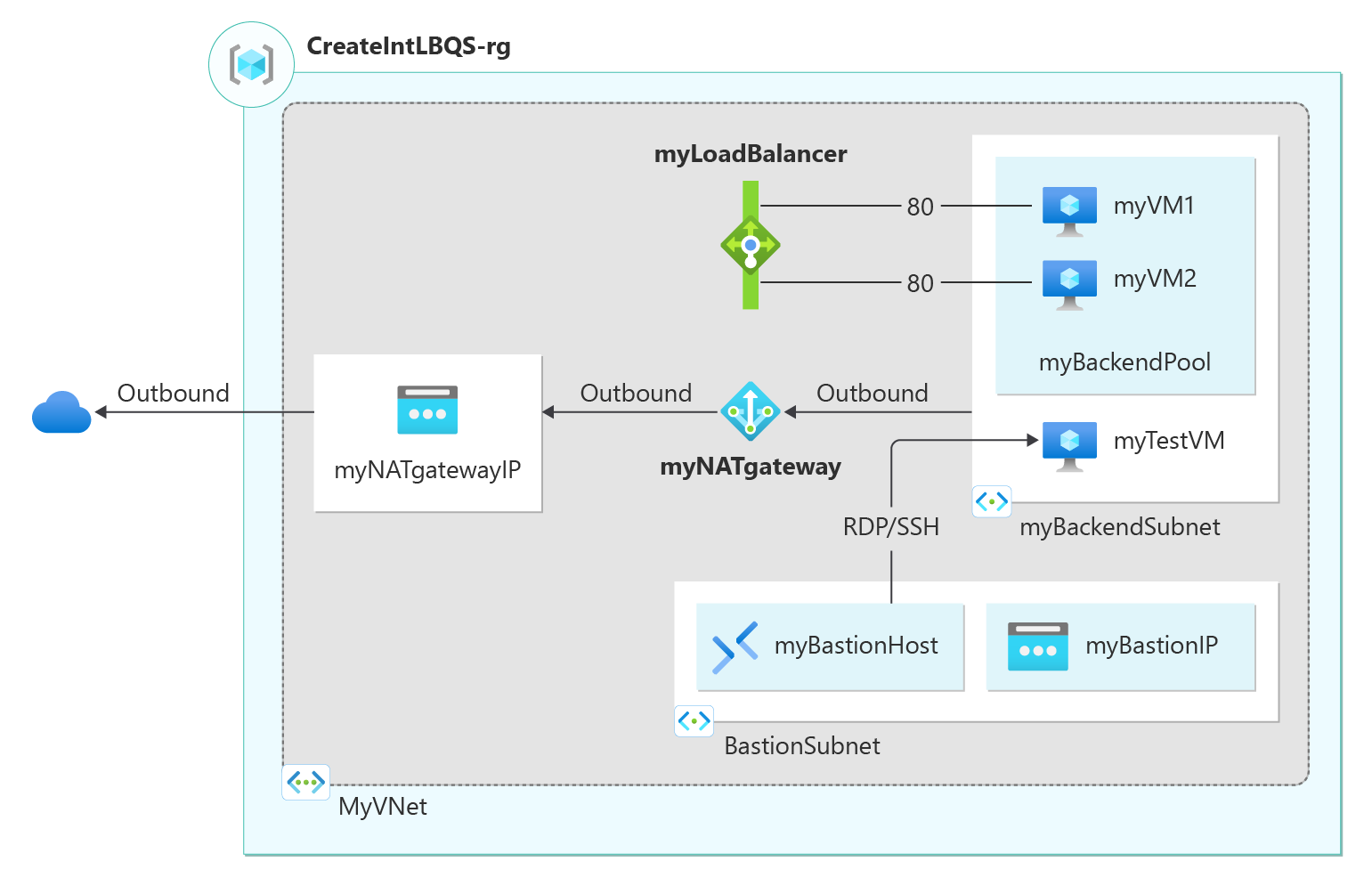本快速入门介绍如何使用 Bicep 文件创建内部 Azure 负载均衡器。 内部负载均衡器将流量分配到位于负载均衡器后端池中的虚拟网络中的虚拟机。 除了内部负载均衡器之外,此模板还会创建虚拟网络、网络接口、NAT 网关和 Azure Bastion 实例。
Bicep 是一种特定于域的语言 (DSL),使用声明性语法来部署 Azure 资源。 它提供简明的语法、可靠的类型安全性以及对代码重用的支持。 Bicep 会针对你的 Azure 基础结构即代码解决方案提供最佳创作体验。
先决条件
如果没有 Azure 订阅,请在开始前创建一个试用版订阅。
查阅 Bicep 文件
本快速入门中使用的 Bicep 文件来自 Azure 快速入门模板。
@description('Admin username')
param adminUsername string
@description('Admin password')
@secure()
param adminPassword string
@description('Prefix to use for VM names')
param vmNamePrefix string = 'BackendVM'
@description('Location for all resources.')
param location string = resourceGroup().location
@description('Size of VM')
param vmSize string = 'Standard_D2s_v3'
@description('Virtual network address prefix')
param vNetAddressPrefix string = '10.0.0.0/16'
@description('Backend subnet address prefix')
param vNetSubnetAddressPrefix string = '10.0.0.0/24'
@description('Bastion subnet address prefix')
param vNetBastionSubnetAddressPrefix string = '10.0.2.0/24'
@description('Frontend IP address of load balancer')
param lbFrontendIPAddress string = '10.0.0.6'
var natGatewayName = 'lb-nat-gateway'
var natGatewayPublicIPAddressName = 'lb-nat-gateway-ip'
var vNetName = 'lb-vnet'
var vNetSubnetName = 'backend-subnet'
var storageAccountType = 'Standard_LRS'
var storageAccountName = uniqueString(resourceGroup().id)
var loadBalancerName = 'internal-lb'
var networkInterfaceName = 'lb-nic'
var numberOfInstances = 2
var lbSkuName = 'Standard'
var bastionName = 'lb-bastion'
var bastionSubnetName = 'AzureBastionSubnet'
var bastionPublicIPAddressName = 'lb-bastion-ip'
resource natGateway 'Microsoft.Network/natGateways@2023-09-01' = {
name: natGatewayName
location: location
sku: {
name: 'Standard'
}
properties: {
idleTimeoutInMinutes: 4
publicIpAddresses: [
{
id: natGatewayPublicIPAddress.id
}
]
}
}
resource natGatewayPublicIPAddress 'Microsoft.Network/publicIPAddresses@2023-09-01' = {
name: natGatewayPublicIPAddressName
location: location
sku: {
name: 'Standard'
}
properties: {
publicIPAddressVersion: 'IPv4'
publicIPAllocationMethod: 'Static'
idleTimeoutInMinutes: 4
}
}
resource vNet 'Microsoft.Network/virtualNetworks@2023-09-01' = {
name: vNetName
location: location
properties: {
addressSpace: {
addressPrefixes: [
vNetAddressPrefix
]
}
}
}
resource vNetName_bastionSubnet 'Microsoft.Network/virtualNetworks/subnets@2023-09-01' = {
parent: vNet
name: bastionSubnetName
properties: {
addressPrefix: vNetBastionSubnetAddressPrefix
}
}
resource vNetName_vNetSubnetName 'Microsoft.Network/virtualNetworks/subnets@2023-09-01' = {
parent: vNet
name: vNetSubnetName
properties: {
addressPrefix: vNetSubnetAddressPrefix
natGateway: {
id: natGateway.id
}
}
}
resource bastion 'Microsoft.Network/bastionHosts@2023-09-01' = {
name: bastionName
location: location
properties: {
ipConfigurations: [
{
name: 'IpConf'
properties: {
privateIPAllocationMethod: 'Dynamic'
publicIPAddress: {
id: bastionPublicIPAddress.id
}
subnet: {
id: vNetName_bastionSubnet.id
}
}
}
]
}
}
resource bastionPublicIPAddress 'Microsoft.Network/publicIPAddresses@2023-09-01' = {
name: bastionPublicIPAddressName
location: location
sku: {
name: lbSkuName
}
properties: {
publicIPAddressVersion: 'IPv4'
publicIPAllocationMethod: 'Static'
}
}
resource networkInterface 'Microsoft.Network/networkInterfaces@2023-09-01' = [for i in range(0, numberOfInstances): {
name: '${networkInterfaceName}${i}'
location: location
properties: {
ipConfigurations: [
{
name: 'ipconfig1'
properties: {
privateIPAllocationMethod: 'Dynamic'
subnet: {
id: vNetName_vNetSubnetName.id
}
loadBalancerBackendAddressPools: [
{
id: resourceId('Microsoft.Network/loadBalancers/backendAddressPools', loadBalancerName, 'BackendPool1')
}
]
}
}
]
}
dependsOn: [
vNet
loadBalancer
]
}]
resource loadBalancer 'Microsoft.Network/loadBalancers@2023-09-01' = {
name: loadBalancerName
location: location
sku: {
name: 'Standard'
}
properties: {
frontendIPConfigurations: [
{
properties: {
subnet: {
id: vNetName_vNetSubnetName.id
}
privateIPAddress: lbFrontendIPAddress
privateIPAllocationMethod: 'Static'
}
name: 'LoadBalancerFrontend'
}
]
backendAddressPools: [
{
name: 'BackendPool1'
}
]
loadBalancingRules: [
{
properties: {
frontendIPConfiguration: {
id: resourceId('Microsoft.Network/loadBalancers/frontendIpConfigurations', loadBalancerName, 'LoadBalancerFrontend')
}
backendAddressPool: {
id: resourceId('Microsoft.Network/loadBalancers/backendAddressPools', loadBalancerName, 'BackendPool1')
}
probe: {
id: resourceId('Microsoft.Network/loadBalancers/probes', loadBalancerName, 'lbprobe')
}
protocol: 'Tcp'
frontendPort: 80
backendPort: 80
idleTimeoutInMinutes: 15
}
name: 'lbrule'
}
]
probes: [
{
properties: {
protocol: 'Tcp'
port: 80
intervalInSeconds: 15
numberOfProbes: 2
}
name: 'lbprobe'
}
]
}
}
resource storageAccount 'Microsoft.Storage/storageAccounts@2023-01-01' = {
name: storageAccountName
location: location
sku: {
name: storageAccountType
}
kind: 'StorageV2'
}
resource vm 'Microsoft.Compute/virtualMachines@2023-09-01' = [for i in range(0, numberOfInstances): {
name: '${vmNamePrefix}${i}'
location: location
properties: {
hardwareProfile: {
vmSize: vmSize
}
osProfile: {
computerName: '${vmNamePrefix}${i}'
adminUsername: adminUsername
adminPassword: adminPassword
}
storageProfile: {
imageReference: {
publisher: 'MicrosoftWindowsServer'
offer: 'WindowsServer'
sku: '2019-Datacenter'
version: 'latest'
}
osDisk: {
createOption: 'FromImage'
}
}
networkProfile: {
networkInterfaces: [
{
id: networkInterface[i].id
}
]
}
diagnosticsProfile: {
bootDiagnostics: {
enabled: true
storageUri: storageAccount.properties.primaryEndpoints.blob
}
}
}
}]
output location string = location
output name string = loadBalancer.name
output resourceGroupName string = resourceGroup().name
output resourceId string = loadBalancer.id
Bicep 文件中已定义了多项 Azure 资源:
- Microsoft.Network/virtualNetworks:负载均衡器和虚拟机的虚拟网络。
- Microsoft.Network/networkInterfaces:虚拟机的网络接口。
- Microsoft.Network/loadBalancers:内部负载均衡器。
- Microsoft.Network/natGateways
- Microsoft.Network/publicIPAddresses:NAT 网关和 Azure Bastion 的公共 IP 地址。
- Microsoft.Compute/virtualMachines:后端池中的虚拟机。
- Microsoft.Network/bastionHosts:Azure Bastion 实例。
- Microsoft.Network/virtualNetworks/subnets:虚拟网络的子网。
- Microsoft.Storage/storageAccounts:虚拟机的存储帐户。
部署 Bicep 文件
将该 Bicep 文件另存为本地计算机上的 main.bicep。
使用 Azure CLI 或 Azure PowerShell 来部署该 Bicep 文件。
az group create --name CreateIntLBQS-rg --location chinanorth3 az deployment group create --resource-group CreateIntLBQS-rg --template-file main.bicep --parameters adminUsername=AzureAdmin注意
将管理员用户替换为管理员用户名<>。 系统还会提示输入 adminPassword。
部署完成后,应会看到一条指出部署成功的消息。
查看已部署的资源
使用 Azure 门户、Azure CLI 或 Azure PowerShell 列出资源组中已部署的资源。
az resource list --resource-group CreateIntLBQS-rg
清理资源
如果不再需要资源组及其资源,请使用 Azure 门户、Azure CLI 或 Azure PowerShell 将其删除。
az group delete --name CreateIntLBQS-rg
后续步骤
有关引导你完成 Bicep 文件创建过程的分步教程,请参阅:
